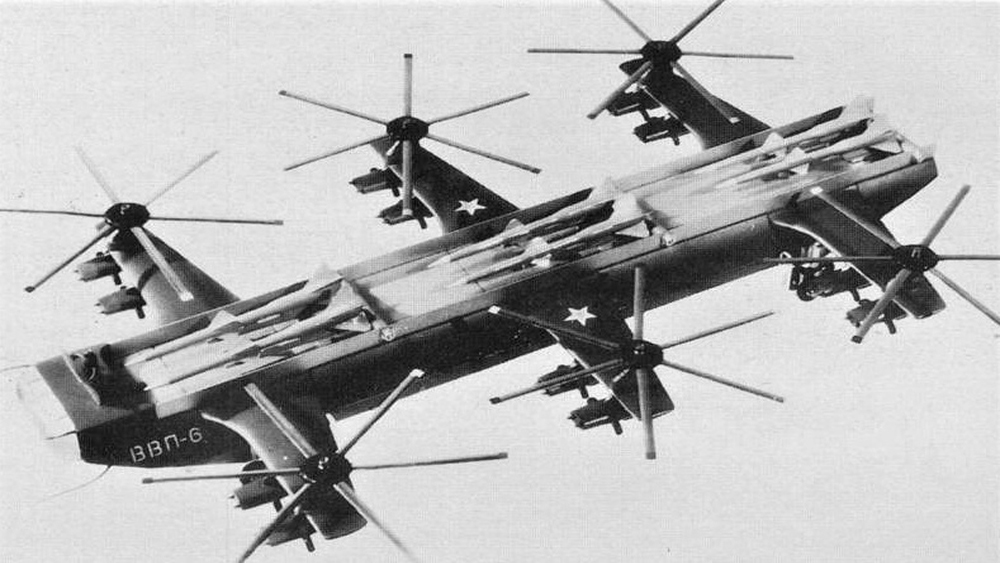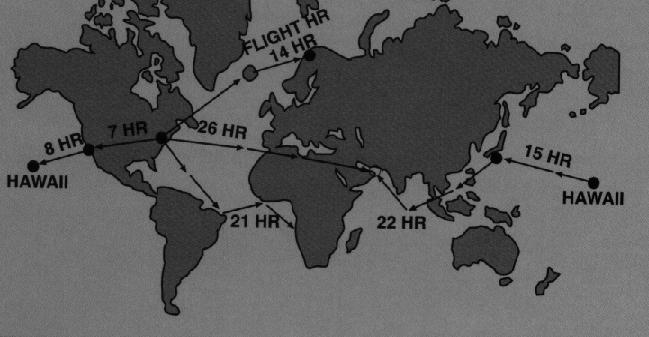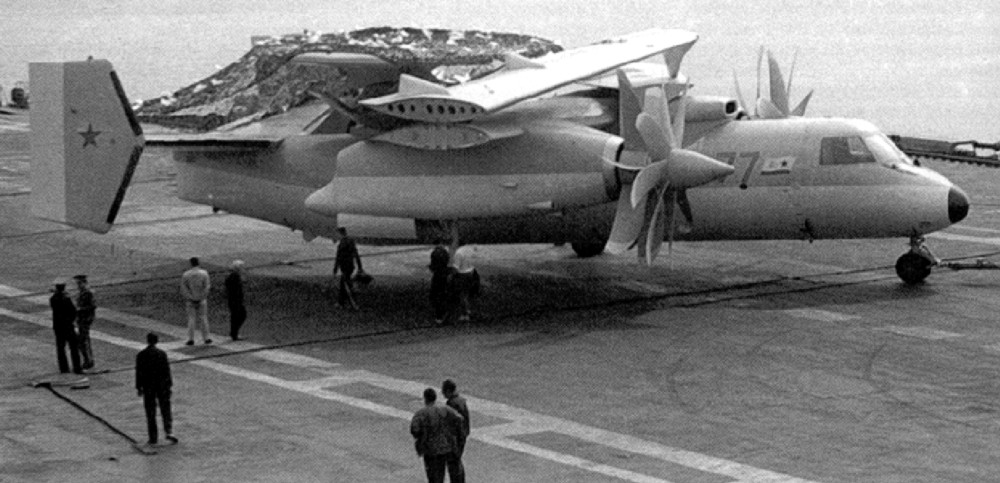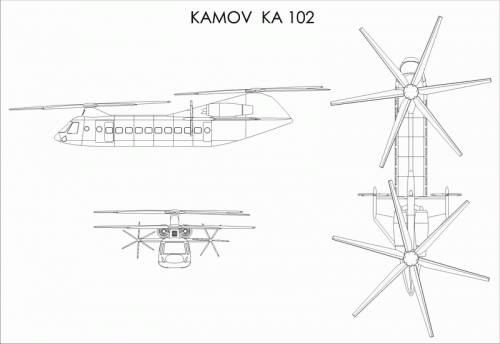Sometimes a concept could be also parked for years, waiting for proper conditions (e.g. the existence of an initial (potential) customer for the product and/or the need of some associated required technologies to mature to an acceptable level) and then later "resuscitated
The problem here is that tandem rotor design and tilt rotor design aircraft are fundamentally different from any kind of aircraft they currently have in service and production, so any suggestion to put them in to production need to clearly and definitively prove beyond doubt that it is worth the expense.
Right now there is no reason to believe any type of tandem or tilt rotor aircraft could substantially exceed the performance of a naval AWACS aircraft based on the Yak-44 design... in fact it is quite certain they will be substantially inferior in many ways.
For other roles they are already developing a high speed coaxial helicopter design with the speed of the tilt rotor... now lets be clear the purpose of the tilt rotor is vertical take off with speed double or even triple that of a similar conventional helicopter.
The design they are working on has a speed of 500km/h which is pretty much as fast as a tilt rotor is going to be so why bother going to the effort and expense of making tandem rotor helicopter designs or tilt rotor aircraft designs if the speed requirement is already to be achieved with a design they are more familiar with and can be applied to existing types already in service?
In addition, sometimes particular studies are done to compare performances and characteristics of different engine or aircraft architectures, and to be able to justify that staying with the "baseline" architecture is still the better compromise.
Indeed, the best way to ensure your equipment is superior is to compare it with the alternative... the R-27 missile family competed against what was effectively a modification of the Sparrow AAM. It won by the way, though the Soviet Sparrow was actually rather superior to the US Sparrow and had different wing shapes, which was largely hidden with black paint most of the time... most western magazines depict the missile as having the same triangular wings as the Sparrow but they were actually a completely different shape but black paint with white triangular outlines fooled the westerners...
If the alternative offers some advantages in comparison to the "baseline" architecture, they still need to evaluate when the new technology or architecture can be ready, and develop a sort technology and manufacturing readiness strategy.
They can also spy on experience the enemy has had with the technology... some areas of superiority are not relevant... and some important features might be kept from the media... for instance hiding problems like poor maintainability, or high operational costs, systems not actually working properly.... etc etc.
Normally that means many years would be still needed before the new project could be commercialized, while a new product with improved existing architecture will take much less.
Indeed... something that is only slightly better but will be ten times more expensive and will take 5 years to get into service... there are other things you can spend money on.
Now if the Russians didn't have coaxial rotor helos then a tandem helicopter would be brilliant... tail rotors on decks are incredibly dangerous, but the have coaxial designs and they work just fine.
Note this stuff about having a bigger internal area with a tandem design is rubbish... the internal space on an Mi-6 is just fine, and the Mi-26 is even better.
They could even make a high speed coaxial tandem-rotor helo with smaller diameter rotors, & it will have cruise speed close to a tilt-rotor & possibly a higher payload.
To get rotor blade clearance between rotor sets it would need to be too big to be useful...
they were to bring BM to silos in Urals & Altai mountains as well.
What silos?
Train would be rather more efficient.
IMO, those even slightly exceeding Mi-12/26/38 specs will be worth it.
Worth it because it would be cool?
Or worth it because there is a specific use for them that they need to get done but can't because they currently lack the right sort of helicopter to get the job done?
even if they make it in many variants to replace the Mi-14/17s, that still leaves the need for naval helos like CH-46.
They are developing a Helix replacement already, that is a different programme.
If the USN had a better tandem helo, they wouldn't be training with, & using their Army CH-47s as much on/of their ships.
So maybe it is the USN that needs a new helicopter perhaps?
the 1st flight in planned for 2020 or so, so it's clear a prototype will be built.
They also built Yak-44s and Yak-141s...
if they produce a similar aircraft with IRPs, 2-3 of them can do a job of 1 An-12/72 or IL-112/276 & land anywhere
Not anywhere, that is bullshit.... they will need a small area of level firm ground.
They used to claim the Harrier could land anywhere and that turned out to be bullshit...
Also two might do the job of a bigger aircraft... for 100 times more cost.
as mentioned, the USSR Border Guards used Mi-8s/17s, not any Mi-14s, to patrol the coastlines over water for years, & the navalized AH-64s now serve in the RN.
So if they are clearly happy with hips then why piss away money on a hip replacement? (old fogie humour there...)
but they may do some jobs better, so it's worth it IMO.
You are not getting it... these aircraft you are proposing will cost millions and millions of dollars... you can't just develop a new type of aircraft because it might be useful for some things. International airliners are not all required to be fully amphibious just in case there is an emergency and they have to be able to land... or be diverted to save someone who has fallen off a yacht and needs to be rescued...
They can move supplies & people directly to/from ships w/o the need for planes & long strips.
Ships are vastly more efficient for that sort of thing, and they can transport fuel at the same time...
still a tandem helo is more capable than a similar size helo with only 1 main rotor, so it may be worth 1.5-2 of them.
Based on what evidence?
The US uses a tandem rotor helicopter... big fucking deal. Russia uses coaxial rotor helicopters that are a fraction of the size yet can manage payloads of 50% for a purchase price about 20% that fit on even some of their corvettes...
yes, & it looks like a modern Western small helo, different than anything Mil produced so far.
We going to cheapen this discussion to that level are we?
so is Sikorsky in the US. Good luck to them both!
You mean Sikorsky is going to upgrade their inferior range by copying Kamovs rotor design? ... see above.
wanting something isn't = it shall happen.
Actually at the design stage, yes it is...
That is the whole point of designing it yourself rather than modifying an existing type.
Antonov wanted a C-130 equivalent, but its An-12 came out inferior in internal volume, speed & range.
Antonov was given specs and requirement levels to meet. The C-130 was designed to do jobs for the US military and was not intended to handle or carry Soviet equipment. The An-12 didn't need to be a C-130, just like the C-130 didn't need to be the An-12.
the An-225 is better than the An-124.
Wrong wrong wrong. The An-225 never entered mass production because it is a one trick pony... most customers world wide would have trouble filling it or using its full potential... and all the while it burns more fuel than the An-124 every km it flies... it is more expensive to operate, yet the extra weight capacity it can carry would rarely be needed most of the time.... a white elephant.
I think the site explains it; a B-52 is better than a B-47
Lack of suitable engines... the easiest way to improve a Boeing 747 is to replace its four engines with two bigger more powerful more fuel efficient engines. The way to make it worse is to replace the four engines with 8 smaller less powerful ones...
[qutoe]If they can't get the An-70 & need extra airlift capability as their remaining An-12s & some older IL-76 will be retiring soon. [/quote]
They don't use An-12s AFAIK for much (VDV), they basically usually use Il-76s. The new Il-476s will be just as good as the Il-76s were, in fact they will probably be able to carry more vehicles in the newer aircraft.
There's no new An-124, & the cost of producing, maintaining, upgrading & using it instead of brand ne surplus A400M (ther'll be 13[!] of them, as some countries opted out) may be equal/more.
They have production facilities to make An-124s if they want, they just don't need any more, but the main reason they wont buy A-400Ms is the same they are not currently producing more An-124s... the engine is foreign and would be enormous expensive and a serious pain in the ass to keep running.
Il-476s would be superior in every way than an A-400M and likely rather cheaper to buy and operate too.
Once they are in full mass production propfan versions might be considered... or maybe not, but it is certainly by a vast margin the best option if the alternatives are An-70 resurrections or A-400M revivals... hey maybe they should order 500 of them from France and then at the last minute cancel the deal because of the undemocratic way the French government is treating the yellow shirts and demand their money back in full...
with more planes, they'll have less wear & tear, increasing their life span & decreasing maintenance/attrition costs. Civilians may also use them, helping the economy, earning $ & paying taxes.
All the more reason to add orders for the Il-476 and produce rather more of them... I am sure civilian orders will be significant too as there are a lot of Il-76s out there doing a great job that need upgrades and replacements... not many civilian operators want to shell out half a billion per aircraft to buy C-17s that the US can tell them can't be used for certain jobs due to current sanctions...
It may be worth more to develop tandem/tilt-rotor aircraft than a special IL-276 variant.
OK... lets break down why this is a very stupid and naieve thing to say.
The Il-276 is a scaled down Il-476... it is a programme that is going forward... there is no question this aircraft will be made... there is a clear solid requirement for it.
Now you are trying to suggest that designing a propfan engine from a turbofan engine and putting it on some spare Il-276s they can produce over and above the ones they are producing to replace the An-12s in service might be too hard and instead they should invent tandem helicopter technology or tilt rotor helicopter technology from scratch... presumably also needing brand new engines designed especially for them too?
GET REAL BUDDY.
Tandem rotor designed helos are complicated designs that have a lot of problems and issues... not the least of which synchronising two sets of main rotors so they don't collide in flight... flexure of the aircraft structure because of the torque from the two main rotors trying to snap the structure in two by bending each end, and of course the problems of power transmission so the engines can keep powering both rotor blades even if one engine fails.
A tilt rotor is even more of a pain in the ass because it needs to be balanced on the lift of two main rotors... it is like riding a bike... except when you fall off everybody dies.
Both aircraft types would be enormously expensive to develop... and for what?
There is no ready captive market.... you could spend billions developing them as Kamov and Yakovlev comes in a puts propfan engines on an Il-276 and for a fraction of the price you could sell your product (at a loss) they can take the contract for 12-15 ton payload light transport.
The customer gets to choose between an enormously expensive very slow tandem rotor helicopter that any conventional transport aircraft could run rings around so it wont even get considered... so scrap that. They could also choose a tilt rotor aircraft that is also slow and risk and short ranged and to carry a 10-15 ton payload we are talking about a V-44 rather than a V-22, so burns lots of fuel and enormous footprint, not to mention risky and horribly expensive to buy and operate... or they can have an aircraft design that has its internal cross section unified with the standard C-130 and C-141 equivalents in the Russian military... its avionics are all brand new and state of the art and unified with other aircraft already in service... and much much cheaper.
If they need a VTOL aircraft with a payload of 10 tons they have the Mi-6, if they need one with a payload of 20 tons they have one with the Mi-26, if they need one with a payload of 12-15 tons they are developing one with the Chinese now...
There is no need for a tandem helicopter design or a tilt rotor design for the Russian military.
They might not even bother with the Il-276 with propfan engines... just with standard engines it should be able to operate from rough airstrips... the only aircraft they need to fly slower to improve performance at paradropping is the Il-476, which with propfans and extra high lift devices on its wings could easily do the job the An-70 was supposed to do... much cheaper, and retaining commonality with existing Russian aircraft types.
Russia can already get the capacity from existing conventional types, and they are working on getting higher speed from new high speed types, which makes the tilt rotor design less desirable and more risky.
Just for you:
The VVP-6...

http://www.aviastar.org/helicopters_eng/yak_vvp-6.php









